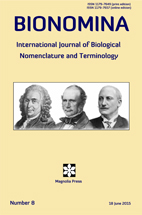Abstract
The taxonomic urgency, caused by the combination of the taxonomic gap (wide incompleteness of the taxonomic inventory of living beings on earth) and the biodiversity crisis (major threats of extinction on a large part of the current biodiversity) imposes heavy responsibilities on the scientific community of biologists and particularly of taxonomists. In order to become more efficient in the work of description and naming of the species and other taxa, some changes in traditional working practices should be implemented. Among them, a simplification and standardisation of some nomenclatural Rules and practices, and in particular of the way of writing the scientific names of taxa (nomina) should be considered. Although traditionally considered important, authorship plays no role in the implementation of the nomenclatural Rules concerning availability, allocation and validity of nomina, and the traditional emphasis put on authorship in nomenclature plays in fact a negative role in taxonomy. Removing the names of authors, but not the date, from the nominal-complex by which each taxon is designated would de-emphasise the role of authorship in nomenclature. It would reduce the burden of nomenclatural taxonomic inflation and synonymy load due to nomenclatural mihilim and unwarranted descriptions of new taxa that will later have to be treated as synonyms. Other proposals regarding the standards and length of writing nominal-complexes in publications are offered, which should be beneficial not only to scientific publications using nomina of taxa, but also to the computerisation of nomenclatural information and its electronic diffusion. These proposed changes, some of which are drastic, should not be implemented at once, but in several steps, in order to be progressively adopted by the community of taxonomists.

